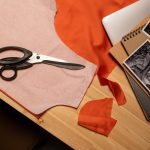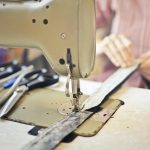Considering the meticulous effort required to create flawless buttonholes manually, you may contemplate the value of a buttonhole making machine for your fabric endeavors. Investing in such a machine can significantly elevate the efficiency and precision of your projects.
As you delve into the decision-making process, evaluating the time-saving benefits, improved quality, and versatility of the machine will be crucial. This introduction will explore the factors to consider when determining whether a buttonhole making machine is a worthwhile addition to your toolkit.
Key Takeaways
- Buttonhole making machines save significant time on fabric projects by automating the process and completing projects in a fraction of the time.
- These machines ensure improved quality and consistency in buttonholes, with precise and uniform sizes and shapes, while also creating sturdy and durable buttonholes.
- Cost analysis and budget considerations should be taken into account when deciding to invest in a buttonhole making machine, including comparing costs, factoring in long-term savings potential, and budgeting for necessary accessories and maintenance.
- Buttonhole making machines offer versatility and a wide range of applications, allowing for various creative possibilities, customized sizes, and intricate patterns beyond just making buttonholes.
Time-Saving Benefits
You'll find that a buttonhole making machine significantly speeds up your fabric projects, allowing you to complete them in a fraction of the time it would take by hand. Time management is a crucial aspect of any fabric project, and a buttonhole making machine can greatly enhance productivity.
By automating the process of creating buttonholes, you eliminate the need to manually measure, mark, and stitch each one, saving you valuable time. This time-saving benefit is especially significant when you have multiple buttonholes to create, such as in making a shirt or a jacket.
The machine's efficiency in producing consistent and precise buttonholes also contributes to time management, as it reduces the likelihood of errors that would require time-consuming corrections.
With the productivity enhancement offered by a buttonhole making machine, you can take on more complex projects or increase the volume of items you produce, all within a shorter timeframe. Ultimately, investing in a buttonhole making machine can revolutionize the way you approach fabric projects, allowing you to achieve more in less time.
Improved Quality and Consistency
To achieve improved quality and consistency in your fabric projects, a buttonhole making machine streamlines the process, ensuring precise and uniform buttonholes with minimal effort. This results in improved efficiency and consistent results, making it a worthwhile investment for your fabric projects.
Here's how a buttonhole making machine can enhance the quality and consistency of your work:
- Precision: The machine's automated process ensures that each buttonhole is precisely cut and stitched to the same measurements every time, eliminating human error and variation.
- Uniformity: With a buttonhole making machine, you can expect consistent buttonhole sizes and shapes across all your fabric pieces, giving your projects a professional and polished look.
- Time-saving: By automating the buttonhole making process, the machine allows you to complete projects efficiently, freeing up time for other aspects of your work.
- Durability: The machine creates sturdy and durable buttonholes that can withstand regular use and washing, ensuring the longevity of your fabric projects.
Investing in a buttonhole making machine not only improves the overall quality of your fabric projects but also provides the consistency and efficiency necessary for mastering your craft.
Cost Analysis and Budget Considerations
When considering the investment in a buttonhole making machine, it's important to compare the costs of different machines and their features.
You should also factor in the potential long-term savings that a buttonhole machine can offer compared to outsourcing services.
Additionally, it's essential to budget for any necessary accessories or maintenance costs to ensure a comprehensive cost analysis.
Machine Cost Comparison
If you want to assess the cost-effectiveness of a buttonhole making machine for your fabric projects, it's essential to compare the prices and consider your budget carefully.
When comparing the costs of buttonhole making machines, consider the following factors:
- Initial Investment: Compare the upfront cost of purchasing the machine. Look for a balance between affordability and quality.
- Maintenance Expenses: Consider the long-term costs associated with maintenance, including servicing, repairs, and replacement parts.
- Operational Costs: Factor in the expenses related to the machine's operation, such as electricity consumption and the need for additional accessories or attachments.
- Return on Investment (ROI): Evaluate the potential ROI by weighing the machine's efficiency in producing quality buttonholes against the initial and ongoing costs.
Careful consideration of these cost factors will help you make an informed decision regarding the purchase of a buttonhole making machine for your fabric projects.
Long-Term Savings Potential
Considering the long-term savings potential and budget implications, you can assess the overall cost-effectiveness of investing in a buttonhole making machine for your fabric projects. When evaluating the initial investment and return on investment, it's essential to weigh the upfront cost against the potential long-term savings. Below is a cost analysis comparing the initial investment of purchasing a buttonhole making machine versus the ongoing expenses of outsourcing buttonhole creation.
| Cost Category | Buttonhole Making Machine | Outsourcing Buttonholes |
|---|---|---|
| Initial Investment | Higher | Lower |
| Ongoing Expenses | Minimal | Higher |
| Long-Term Savings Potential | Significant | Limited |
Budgeting for Accessories
To budget for accessories when considering a buttonhole making machine, assess the initial cost and ongoing expenses involved. When analyzing the costs, consider the affordability of the following accessories and options:
- Buttonhole presser feet: Research and compare the prices of different buttonhole presser feet compatible with your machine to find cost-effective options.
- Maintenance and repairs: Estimate the expenses for regular maintenance and potential repairs to include in your budget.
- Additional attachments: Determine the need for extra attachments such as specialty presser feet and bobbins, factoring in their costs.
- Training and resources: Account for the cost of training materials or classes to maximize the benefits of your buttonhole making machine investment.
Versatility and Range of Applications
You'll find that a buttonhole making machine offers a wide range of applications and impressive versatility for your fabric projects. This machine is not limited to just making buttonholes; it can be used for various creative applications and design possibilities, making it an indispensable tool for any sewing enthusiast. Take a look at the table below to see the diverse range of applications and design possibilities that a buttonhole making machine can offer.
| Applications | Design Possibilities |
|---|---|
| Apparel | Varying buttonhole styles |
| Home decor | Customized buttonhole sizes |
| Accessories | Intricate buttonhole patterns |
As demonstrated in the table, a buttonhole making machine can be used for creating buttonholes in apparel, customizing buttonhole sizes to fit specific buttons, and crafting intricate buttonhole patterns for various accessories. This level of versatility allows you to explore and execute a wide range of design ideas, bringing your fabric projects to life with precision and finesse.
Comparison With Manual Buttonhole Techniques
Exploring the efficiency of buttonhole making machines versus manual buttonhole techniques highlights the potential time-saving benefits and consistent results achieved by utilizing automated processes.
When comparing with manual buttonhole techniques, buttonhole making machines offer several advantages:
- Time-Saving Benefits: Buttonhole making machines can create multiple buttonholes in a fraction of the time it takes to manually sew each one. This not only speeds up the production process but also allows for greater efficiency in completing fabric projects.
- Consistent and Professional Finish: Automated buttonhole making machines produce uniform and precise buttonholes, ensuring a professional and polished look across all buttonhole placements. This consistency is often challenging to achieve with manual techniques, especially when creating numerous buttonholes.
- Ease of Use: Buttonhole making machines are designed to be user-friendly, requiring minimal effort and expertise to operate effectively. This makes them accessible to a wide range of users, including those with varying levels of sewing experience.
- Versatility: Many buttonhole making machines offer a variety of buttonhole styles and sizes, allowing for greater customization and flexibility in fabric projects.
User-Friendly Features and Operation
When considering a buttonhole making machine, it's important to assess its user-friendly features and operation.
Look for easy-to-use designs that cater to beginners, as well as intuitive features that enhance overall efficiency.
These aspects can significantly impact the machine's usability and your experience with it.
Easy Operation for Beginners
When starting out with a buttonhole making machine, ensuring user-friendly features and operation will help simplify the process for beginners. Here are some aspects to consider for easy operation:
- Automatic Functions: Look for a machine with automatic features such as thread tension adjustment and stitch length control to reduce the learning curve.
- Clear Instructions: Opt for a machine that provides clear and concise instructions, including visual aids, to assist beginners in understanding the operation.
- Simple Interface: A buttonhole making machine with an intuitive and easy-to-navigate interface can make the learning process smoother for beginners.
- Support Resources: Consider machines that come with online tutorials, customer support, or community forums to seek guidance and troubleshooting tips as you familiarize yourself with the equipment.
Choosing a buttonhole making machine with these beginner-friendly features can significantly ease the operation process for those new to using the equipment.
Intuitive Features for Efficiency
Consider a buttonhole making machine with intuitive features that enhance efficiency and user-friendliness, making your fabric projects more streamlined and enjoyable.
Intuitive design is crucial for simplifying the buttonhole creation process. Look for machines with easy-to-understand controls and clear labeling, allowing for quick adjustments and minimal errors.
Workflow optimization is another key aspect to consider. Seek machines with automatic features such as one-step buttonhole creation, adjustable stitch length and width, and built-in thread cutters. These features not only save time but also ensure precision and consistency in your buttonhole production.
Additionally, some machines offer programmable memory settings for frequently used stitch patterns, contributing to an even smoother workflow.
Prioritizing intuitive features in a buttonhole making machine can significantly enhance your efficiency and overall fabric project experience.
Maintenance and Long-Term Durability
If you want your buttonhole making machine to last and function at its best, it's crucial to prioritize regular maintenance and care. Here are some essential maintenance tips to ensure the long-term durability of your buttonhole making machine:
- Regular Cleaning: Dust, lint, and fabric particles can accumulate in the machine, leading to malfunctions. Clean the machine after each use and schedule deep cleaning sessions periodically.
- Lubrication: Proper lubrication of moving parts is essential for smooth operation. Follow the manufacturer's guidelines for lubrication frequency and use recommended lubricants.
- Adjustment and Calibration: Periodically check and recalibrate the machine to ensure accurate stitch formation and buttonhole sizing.
- Professional Servicing: While regular maintenance can prevent many issues, professional servicing by a qualified technician is essential to address any underlying problems and ensure optimal performance.
Following these maintenance practices can help minimize maintenance costs and extend the longevity of your buttonhole making machine.
Additionally, familiarize yourself with troubleshooting tips provided in the machine's manual to address common issues promptly.
Frequently Asked Questions
Can a Buttonhole Making Machine Be Used for Creating Buttonholes on Non-Fabric Materials Such as Leather or Vinyl?
Yes, a buttonhole making machine can be used for creating buttonholes on non-fabric materials such as leather. It provides precise and durable leather applications. For vinyl buttonholes, ensure the machine is equipped with the appropriate settings for this material.
Are There Any Specific Maintenance Requirements for Buttonhole Making Machines, Such as Regular Cleaning or Oiling?
Regular maintenance for buttonhole making machines is essential. Cleaning and oiling ensure smooth operation. If creating leather buttonholes or custom shapes, proper upkeep is crucial for optimal performance. Ensure you follow manufacturer guidelines for maintenance.
Can a Buttonhole Making Machine Be Used for Creating Unique or Custom-Shaped Buttonholes, or Is It Limited to Standard Buttonhole Shapes?
Yes, a buttonhole making machine can be used to create custom and decorative buttonholes. Its versatility allows for unique shapes, expanding your options for fabric projects. This machine offers the flexibility needed for intricate designs.
How Does the Noise Level of a Buttonhole Making Machine Compare to Other Sewing Machines or Equipment?
When comparing the noise level, a buttonhole making machine operates efficiently and quietly, similar to modern sewing machines. This ensures a comfortable working environment, allowing for focused and uninterrupted fabric projects without disruptive noise.
Are There Any Potential Limitations or Drawbacks of Using a Buttonhole Making Machine for Certain Types of Fabric or Projects?
Potential limitations may arise with delicate fabrics as buttonhole machines can be too powerful. Fabric compatibility is crucial; some machines may not be suitable for specific projects. Consider the machine's suitability for your project.
- How Does Ring Spun Cotton Affect Garment Fit and Shape Retention? - August 13, 2024
- What Are the Challenges in Producing Ring Spun Cotton? - August 13, 2024
- Is Ring Spun Cotton Suitable for Plus-Size Clothing? - August 13, 2024






